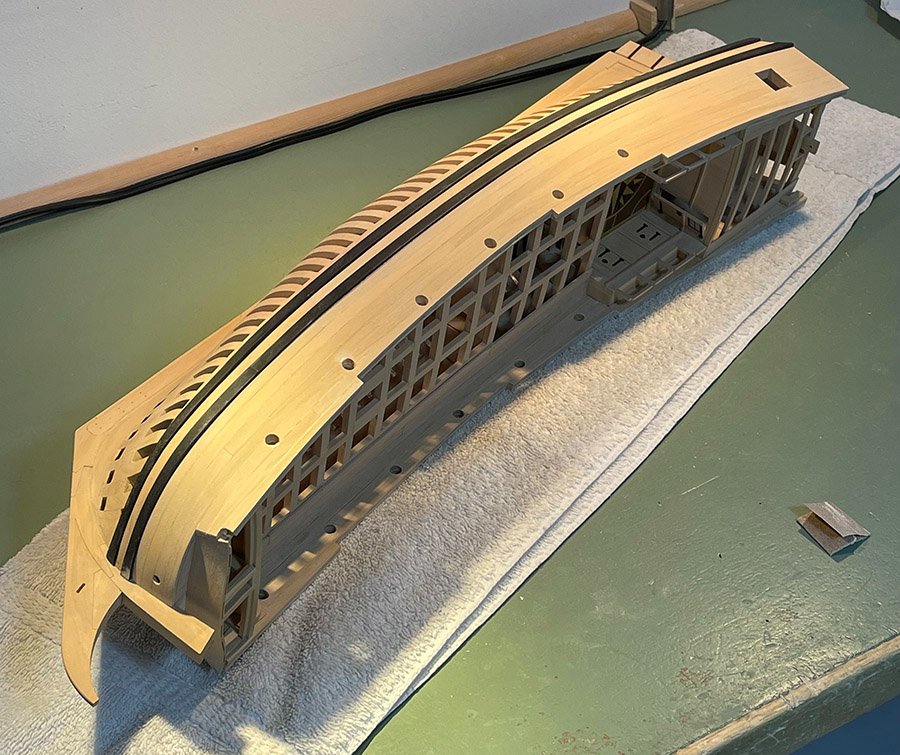-
Posts
13,375 -
Joined
-
Last visited
Content Type
Profiles
Forums
Gallery
Events
Everything posted by druxey
-
Time for us scratch builders to retire....
- 1,784 replies
-
- winchelsea
- Syren Ship Model Company
-
(and 1 more)
Tagged with:
-
For drawing, wood, a pair of parallel pliers work better.
- 257 replies
-
- pegasus
- Swan-class
-
(and 1 more)
Tagged with:
-

Bow shape of Le François 1683 and La Néréïde 1722
druxey replied to Waldemar's topic in Nautical/Naval History
Pett's 'method' was quite simple and elegant. Unfortunately his methods were lost, and only recently discovered, as he died before writing about them. -

Bow shape of Le François 1683 and La Néréïde 1722
druxey replied to Waldemar's topic in Nautical/Naval History
Moneypenny and Antscherl, A Restoration Yacht’s Design Secrets Revealed, Mariners Mirror, Volume 107, Issue 2, May 2021. Yes, Hubac, the model in the photo is the result of the article quoted. No fudging required at the bow! -

Bow shape of Le François 1683 and La Néréïde 1722
druxey replied to Waldemar's topic in Nautical/Naval History
I can't reproduce research from Mariner's Mirror here, but Phineas Pett in the 1670's and 80's had developed a sophisticated method of designing a fair hull - stem to stern - using arcs and a cono-cuneus curve. These were all proportional to the length of keel and moulded breadth. Here is a hull (work in progress) developed by this method: -
Well done for making the correction! The dolphins thank you as well.
- 3,560 replies
-
- clipper
- hull model
-
(and 2 more)
Tagged with:
-

Bow shape of Le François 1683 and La Néréïde 1722
druxey replied to Waldemar's topic in Nautical/Naval History
It is a fascinating rabbit hole down which to wander! -
Welcome aboard, RH. There are plans of the Fish class in the Royal Museums Greenwich collection: https://www.rmg.co.uk/collections/objects/rmgc-object-85908 https://www.rmg.co.uk/collections/objects/rmgc-object-85907 https://www.rmg.co.uk/collections/objects/rmgc-object-85909
-
Great impression, Keith! And yes, wefalk, 'modern' synthetic is braided rather than spun. However, I suppose one strand of spun line could be colored to give the correct impression.
-

Bow shape of Le François 1683 and La Néréïde 1722
druxey replied to Waldemar's topic in Nautical/Naval History
Thank s for these examples, Waldemar. Would you consider that some of these curves may also have been made using a tapered batten pulled, bow fashion, into a curve? -
Congratulations and well done, Toni. Lovely result of a sweet subject. Of course, now the the question is; what next?
-

Bow shape of Le François 1683 and La Néréïde 1722
druxey replied to Waldemar's topic in Nautical/Naval History
Very instructive, Waldemar! Thank you for that. I've been studying English derivation of ship's lines in the 1680's. Many curves are based on circular arcs, but not all. Some are based on the cono-cuneus curve. -
Superb work as ever, Keith. Perhaps I missed this; but how did you replicate the color-coded synthetic line?
-
At this point you can probably rig this mast in your sleep. Perhaps that's what you dream about anyway!
- 3,560 replies
-
- clipper
- hull model
-
(and 2 more)
Tagged with:
-
Nice to see you back, Michael. You can always post the GWR coach build log on "Shore leave" - hint!
- 2,215 replies
-
A slitting saw blade on a table saw. Heat-softening the brass first and some wax while cutting will help. Mounting the brass on a sacrificial wood backing will also ease the job.
- 1,132 replies
About us
Modelshipworld - Advancing Ship Modeling through Research
SSL Secured
Your security is important for us so this Website is SSL-Secured
NRG Mailing Address
Nautical Research Guild
237 South Lincoln Street
Westmont IL, 60559-1917
Model Ship World ® and the MSW logo are Registered Trademarks, and belong to the Nautical Research Guild (United States Patent and Trademark Office: No. 6,929,264 & No. 6,929,274, registered Dec. 20, 2022)
Helpful Links
About the NRG
If you enjoy building ship models that are historically accurate as well as beautiful, then The Nautical Research Guild (NRG) is just right for you.
The Guild is a non-profit educational organization whose mission is to “Advance Ship Modeling Through Research”. We provide support to our members in their efforts to raise the quality of their model ships.
The Nautical Research Guild has published our world-renowned quarterly magazine, The Nautical Research Journal, since 1955. The pages of the Journal are full of articles by accomplished ship modelers who show you how they create those exquisite details on their models, and by maritime historians who show you the correct details to build. The Journal is available in both print and digital editions. Go to the NRG web site (www.thenrg.org) to download a complimentary digital copy of the Journal. The NRG also publishes plan sets, books and compilations of back issues of the Journal and the former Ships in Scale and Model Ship Builder magazines.







